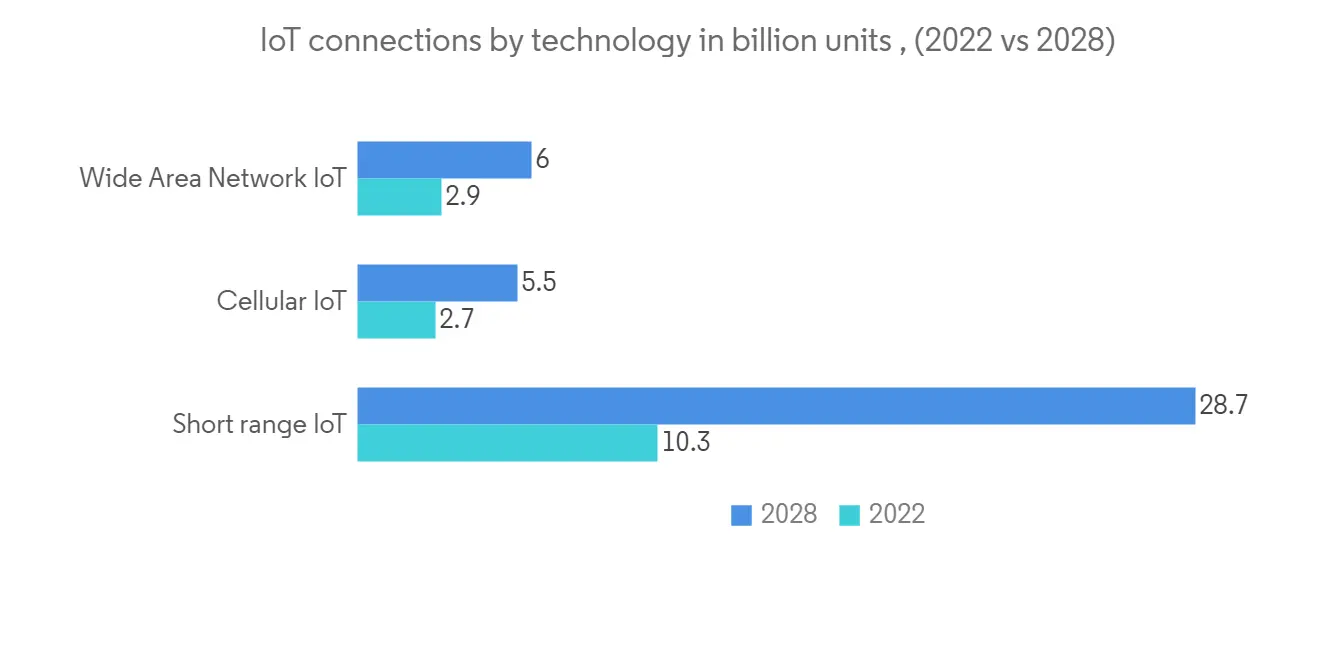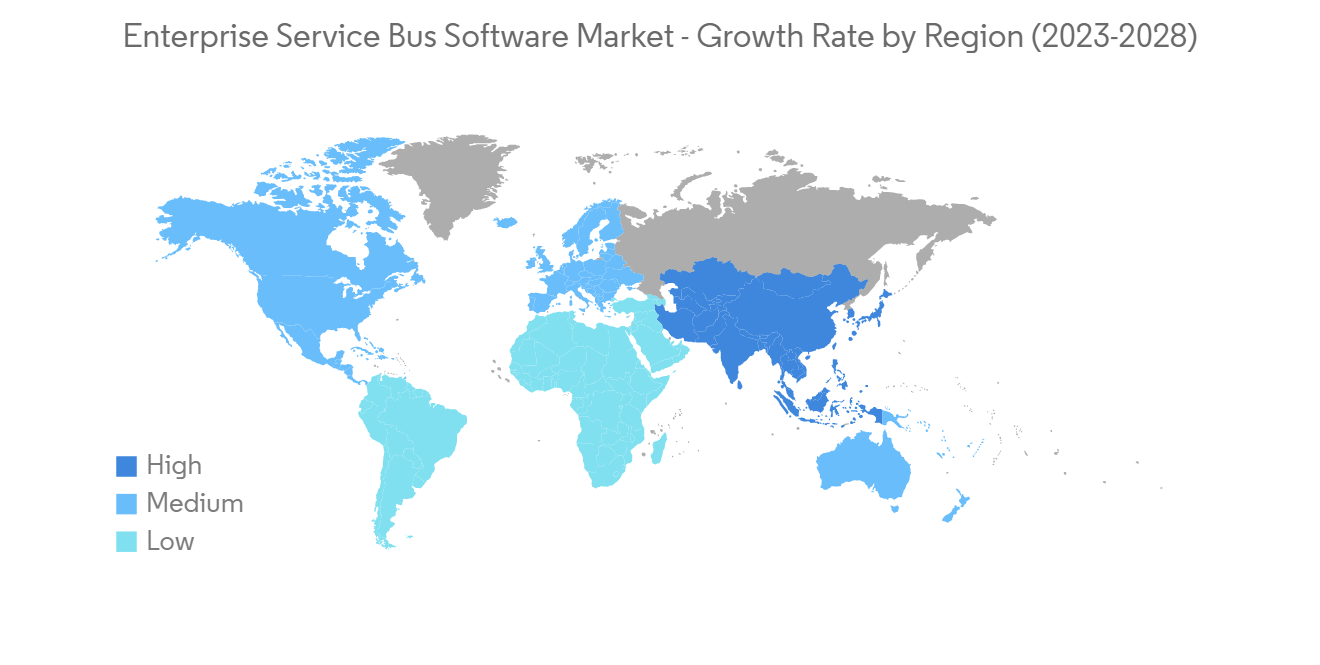 |
市場調查報告書
商品編碼
1273323
企業服務總線 (ESB) 軟件市場——增長、趨勢和預測 (2023-2028)Enterprise Service Bus Software Market - Growth, Trends, and Forecasts (2023 - 2028) |
||||||
※ 本網頁內容可能與最新版本有所差異。詳細情況請與我們聯繫。
在預測期內,企業服務總線 (ESB) 軟件市場預計將以 7.05% 的複合年增長率增長。
由於對跨組織應用程序集成的需求不斷增加,企業服務總線 (ESB) 在企業和組織中變得越來越流行。
主要亮點
- COVID-19 的爆發證明,商業智能、分析、雲計算和移動計算可以幫助組織平穩運行。 從那時起,公司就轉向這些服務來改善他們的工作架構。 這是市場上企業服務總線 (ESB) 軟件的轉折點。
- ESB 架構消除了重寫應用程序的需要,即使在某些網絡和系統不時離線的情況下,也能確保公司之間的快速資訊分發和順暢通信。 出於這個原因,大多數公司都採用 ESB 架構作為其 IT 基礎架構的支柱。
- 此外,作為集成各種應用程序的一種方式,雲端平台的採用一直是一個主要因素,它開闢了新渠道並改善了對客戶數據的訪問,從而產生了更好地滿足客戶需求的產品和服務。由於服務的可用性,預計 ESB 在 IT 和電信行業的使用將顯著增加。
- 例如,擁有 23,000 家分支機構的印度國家銀行選擇了 Microsoft 的雲端生產力解決方案 Office 365,以改善員工之間的溝通和協作,並將其轉變為現代化的工作場所。
- 在紙面上管理數據的老牌公司會發現遷移到雲端的速度很慢,有時還會影響他們開展業務的方式。 此外,數據應該部分更改,而不是一次全部更改。 對高部署成本的擔憂也威脅著市場的增長。
企業服務總線 (ESB) 軟件的市場趨勢
物聯網項目開發的興起推動了市場增長
物聯網連接設備的數量預計將從 2019 年的 86 億增長到 2030 年的 294 億。 連接設備的增長是由新的應用程序和商業模式以及設備標準化和價格下降推動的。
隨著物聯網連接設備數量的增長,設備和數據的集成變得更加複雜。 這些連接的設備可能會給集成和消息傳遞帶來許多挑戰。 因此,組織可能不得不投資於可以通過 ESB 解決的高效應用程序集成解決方案。
處理此問題的最簡單方法是關注在單個應用程序平台上同步不同設備(每個設備具有不同協議)的策略。
在未來幾年,隨著業務環境的變化,需要更有效、更靈活地處理不同設備之間的通信,這將推動對 ESB 軟件的需求。

亞太地區在預測期內將顯著增長
由於中國、印度和韓國等國家/地區越來越關注物聯網平台,預計亞太地區的企業服務總線 (ESB) 軟件市場將增長最快。
隨著越來越複雜的大數據和企業資源規劃 (ERP) 工作負載遷移到雲平台,該地區對基於雲的託管解決方案的需求也在增加。 根據亞洲雲端計算協會 (ACCA) 發佈的一份報告,新加坡憑藉其高水平的寬頻質量、網路安全、監管和業務成熟度,成為亞太地區雲就緒國家中排名第一的國家。。
隨著亞太地區的大多數公司將其業務遷移到雲端,阿里巴巴和騰訊等公司正在使用 ESB 來加快新項目的上市時間並使他們的組織更加靈活。被考慮使用。
通過構建和設計具有更大靈活性的應用程序,企業還可以更快地響應市場變化。 由於這些因素,預計該地區的 ESB 軟件市場也將增長。

企業服務總線 (ESB) 軟件行業概覽
供應商的激增已經分散了企業服務總線 (ESB) 軟件行業。 快速發展、創新和激烈的玩家競爭正在推動 ESB 軟件市場。 其他主要公司包括 Oracle Corporation、Microsoft Corporation、IBM Corporation、SAP SE、MuleSoft Inc. (Salesforce)、Dell Technologies Inc. 和 TIBCO Software Inc.。
2022 年 12 月,紅帽與通用汽車合作,幫助汽車行業參與者將尖端軟件技術集成到他們的產品中。 得益於紅帽的雲原生技術,兩家運營商都將能夠快速為其客戶提供增值功能。 由於汽車軟件需要高水平的網絡安全保護,該軟件將支持多種汽車安全應用,例如高級駕駛輔助系統、車身控制和連接。 Linux 和雲原生技術加速了開源創新進程。
其他福利:
- Excel 格式的市場預測 (ME) 表
- 3 個月的分析師支持
內容
第 1 章介紹
- 調查結果
- 本次調查的假設
- 本次調查的範圍
第 2 章研究方法論
第 3 章執行摘要
第 4 章市場動態
- 市場概覽
- 市場促進因素
- 越來越多地採用基於雲的解決方案
- 物聯網項目增加
- 市場抑制因素
- 高昂的引進成本阻礙了市場增長
- 行業吸引力 - 波特五力分析
- 供應商的議價能力
- 買方/消費者議價能力
- 新進入者的威脅
- 替代品的威脅
- 競爭公司之間的敵對關係
第 5 章市場細分
- 展開
- 雲端
- 本機
- 最終用戶行業
- IT/通訊
- 零售
- 醫療保健
- BFSI
- 其他最終用戶行業(政府、製造業、公用事業)
- 地區
- 北美
- 歐洲
- 亞太地區
- 拉丁美洲
- 中東和非洲
第 6 章競爭格局
- 公司簡介
- Oracle Corporation
- Microsoft Corporation
- IBM Corporation(Red Hat Inc.)
- TIBCO Software Inc.
- SAP SE
- Salesforce.com Inc.(MuleSoft Inc.)
- Dell Technologies Inc.
第 7 章投資分析
第 8 章市場機會與未來趨勢
The Enterprise Service Bus Software Market is poised to register a CAGR of 7.05% during the forecast period. Due to the increasing demand for application integration across organizations, enterprise service buses (ESBs) witnessed a rise in their utilization across enterprises and organizations.
Key Highlights
- The COVID-19 outbreak demonstrated the value of business intelligence, analytics, cloud computing, and mobile computing for ensuring that organizations run smoothly. After this, companies started using these services to improve their work architecture. This was the turning point for enterprise service bus software in the market.
- ESB architecture distributes information across enterprises quickly and ensures the smooth delivery of information, even when some networks or systems are offline occasionally, by eliminating the need to rewrite the application. Thus, most companies implement the ESB architecture as the backbone of their IT infrastructure.
- Furthermore, majorly driven by the adoption of cloud platforms that serve as a way to integrate various applications and can facilitate new and expanded channels as well as improve access to client data, allowing for better-tailored products and services, the IT and telecom industries are expected to mark a significant rise in the use of ESBs.
- Banks are also moving more of their data, processes, and infrastructure to the cloud to take advantage of cloud implementation, which makes it easier for enterprise applications to work together.For instance, the State Bank of India, for its 23,000 branches, chose Office 365, a cloud-powered productivity solution from Microsoft, to improve communication and collaboration among its workforce and transform it into a modern workplace.
- Older businesses that keep their data on paper will take some time to move to the cloud, which could sometimes affect how the business works. They will also have to change parts of the data at a time instead of all of it at once. Concerns about the high cost of installation are also a threat to the growth of the market.
Enterprise Service Bus Software Market Trends
Rising Development of IoT Projects Boosting the Market Growth
The number of IoT-connected devices is expected to increase from 8.6 billion in 2019 to 29.4 billion in 2030. The growth of connected devices is driven by new applications and business models, and it is helped by the fact that devices are becoming more standard and their prices are going down.
As the number of IoT-connected devices increases, the integration of devices and data becomes more complex. These connected devices may present numerous integration and messaging challenges. Organizations, thus, may have to invest in efficient application integration solutions that can be tackled with ESBs.
Also, as there are more and more devices that connect to each other, it is becoming more and more important to manage multiple networks and systems at the same time.The easiest way to deal with this problem is to concentrate on a strategy that involves synchronizing various devices (each with a distinct protocol) on a single application platform.
Over the next few years, demand for ESB software is likely to be driven by the need to handle communication between different devices in a more effective and flexible way as business environments change.

Asia-Pacific to Register a Significant Growth Over the Forecast Period
Asia-Pacific is predicted to have the quickest growth rate for the Enterprise Service Bus Software Market due to the region's expanding emphasis on the IoT platform in nations like China, India, and South Korea.
The rising demand for managed cloud-based solutions has also increased in this region due to complex big data and workloads, such as enterprise resource planning (ERP), being increasingly migrated to cloud platforms. According to a report published by the Asia Cloud Computing Association (ACCA), Singapore is the number one cloud-ready Asia-Pacific country, owing to better broadband quality, cybersecurity, regulation, and business sophistication.
As most businesses in Asia-Pacific move their operations to the cloud, companies like Alibaba and Tencent are likely to use ESBs to make their organizations more flexible by reducing the time it takes for new projects to reach the market.
It also builds and designs applications that are more flexible, which lets companies respond quickly to changes in the market. The ESB software market in the region is also likely to grow because of these factors.

Enterprise Service Bus Software Industry Overview
Due to the proliferation of vendors, the enterprise service bus software industry is fragmented. Rapid development, innovation, and intense player competition are what are driving the ESB software market. In addition to others, some of the major companies are Oracle Corporation, Microsoft Corporation, IBM Corporation, SAP SE, MuleSoft Inc. (Salesforce), Dell Technologies Inc., and TIBCO Software Inc.
In December 2022, Red Hat and General Motors joined to assist the car industry player in integrating cutting-edge software technology into its offerings. Both businesses can quickly provide clients with additional valuable features because of Red Hat's cloud-native technology. This software will support several in-vehicle safety applications, like sophisticated driver assistance systems, body control, and connection, since high levels of cybersecurity protection are necessary for in-vehicle software. Linux and cloud-native technology will speed up innovation processes through open source.
Additional Benefits:
- The market estimate (ME) sheet in Excel format
- 3 months of analyst support
TABLE OF CONTENTS
1 INTRODUCTION
- 1.1 Study Deliverables
- 1.2 Study Assumptions
- 1.3 Scope of the Study
2 RESEARCH METHODOLOGY
3 EXECUTIVE SUMMARY
4 MARKET DYNAMICS
- 4.1 Market Overview
- 4.2 Market Drivers
- 4.2.1 Growing Adoption of Cloud-based Solutions
- 4.2.2 Rising Development of IoT Projects
- 4.3 Market Restraints
- 4.3.1 High Installation Cost to Challenge the Market Growth
- 4.4 Industry Attractiveness - Porter's Five Forces Analysis
- 4.4.1 Bargaining Power of Suppliers
- 4.4.2 Bargaining Power of Buyers/Consumers
- 4.4.3 Threat of New Entrants
- 4.4.4 Threat of Substitute Products
- 4.4.5 Intensity of Competitive Rivalry
5 MARKET SEGMENTATION
- 5.1 Deployment
- 5.1.1 On Cloud
- 5.1.2 On-premise
- 5.2 End-user Industry
- 5.2.1 IT and Telecom
- 5.2.2 Retail
- 5.2.3 Healthcare
- 5.2.4 BFSI
- 5.2.5 Other End-user Industries (Government, Manufacturing, and Utilities)
- 5.3 Geography
- 5.3.1 North America
- 5.3.2 Europe
- 5.3.3 Asia-Pacific
- 5.3.4 Latin America
- 5.3.5 Middle East & Africa
6 COMPETITIVE LANDSCAPE
- 6.1 Company Profiles
- 6.1.1 Oracle Corporation
- 6.1.2 Microsoft Corporation
- 6.1.3 IBM Corporation (Red Hat Inc.)
- 6.1.4 TIBCO Software Inc.
- 6.1.5 SAP SE
- 6.1.6 Salesforce.com Inc. (MuleSoft Inc.)
- 6.1.7 Dell Technologies Inc.




